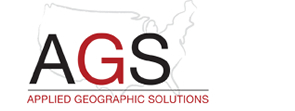Last week, we sent two of our data scientists, Matt Needham, Senior Vice President and Chief Demographer, and Thomas Cannon, Senior Data Scientist, to CARTO’s Spatial Data Science Conference 2025 (SDSC25) in NYC. Below is an account from Matt about the conference, which sounds like it was wonderful and thought provoking.
SDSC25 brought together some of the brightest minds in geospatial data, combining deep technical discussions with forward-looking trends in the industry. The event also served as the launchpad for CARTO’s new AI driven Agentic GIS integration, a feature that lets users refine maps and analytics through natural language conversations with models like Gemini or ChatGPT. Rather than replacing technical expertise, Agentic AI makes it easier for teams to interact with complex data — transforming a steep learning curve into a more intuitive, conversational process. Behind the scenes, though, the system still relies on CARTO workflows, toolkits, and Model Context Protocol (MCP) servers to make that simplicity possible.
Day One was hands-on and immersive, with workshops showcasing these Agentic AI capabilities within the CARTO environment. Thomas and I spent time experimenting with how these tools interact with databases and workflows, and we attended a fascinating session led by researchers from the University of Liverpool. They demonstrated, in real time, how to create population segmentations across the UK using geographic and demographic data in Python. Naturally, we ended up in a long, lively conversation afterward about data manipulation techniques — true kindred spirits.
Day Two shifted to real-world applications, with presentations across industries like healthcare, real estate, education, finance, and the public sector. One of my favorite talks came from the Overture Maps Foundation’s (OMF) Drew Breunig, an open-source initiative backed by companies like Google, Meta, and Amazon. A goal of theirs is to create a shared global reference system — the “Global Entity Reference System,” or GERS — that standardizes how businesses integrate geographic data. It’s an ambitious and exciting concept, and I was glad to see OMF even offers a Python library for exploring it.
Several data warehouse companies also showcased how their systems integrate with CARTO, with plenty of friendly competition on display. On the technical side, there was a lot of discussion about segmentation systems (like our own Panorama), embeddings, autoencoders, and geographic foundation models. Some of these products are fascinating but definitely “black box” in nature — potentially powerful, but worth approaching with caution. (That said, I’ll always advocate for Panorama, which combines transparency with a strong statistical foundation.)
Between sessions and at the after-party, we had plenty of opportunities to meet with CARTO customers, prospects, and staff — including Javier de la Torre, CARTO’s founder, which was a real highlight.
All in all, SDSC25 was an inspiring, idea-filled couple of days. It’s always energizing to see how fast our field continues to evolve — and to connect with others who are just as enthusiastic (and yes, a little nerdy) about the future of spatial data science.


Recent Comments